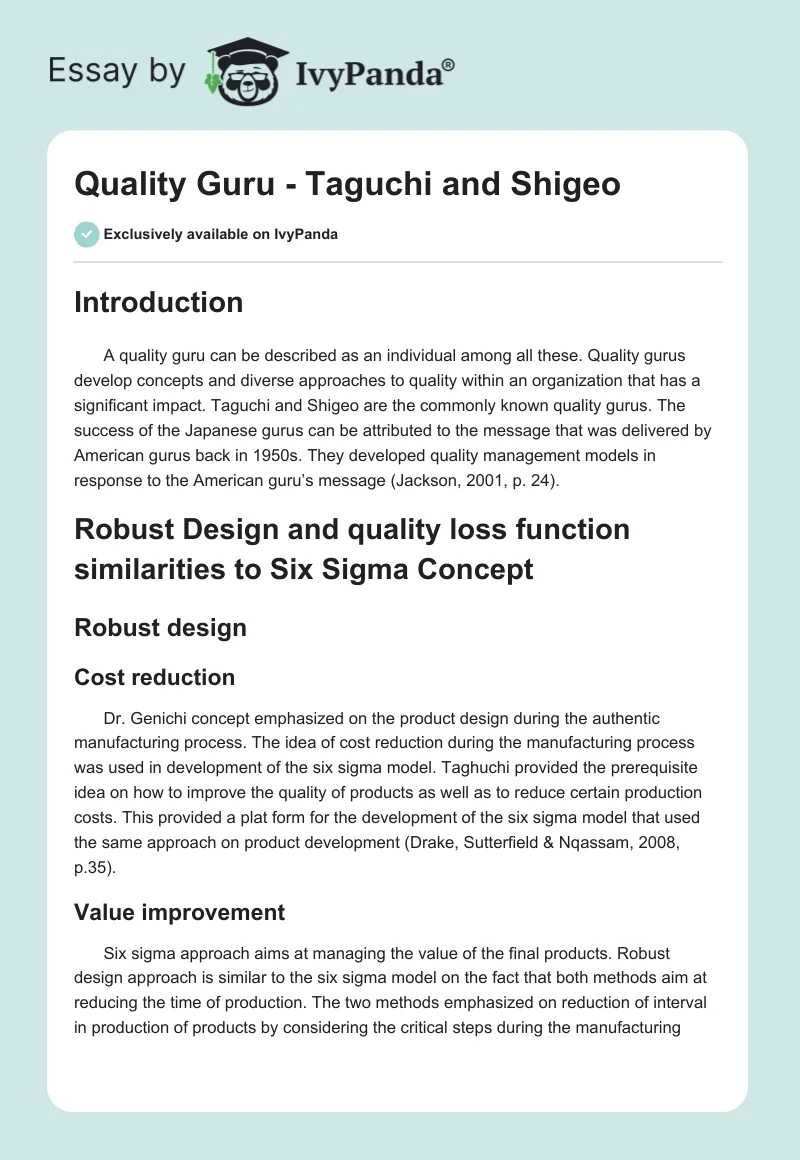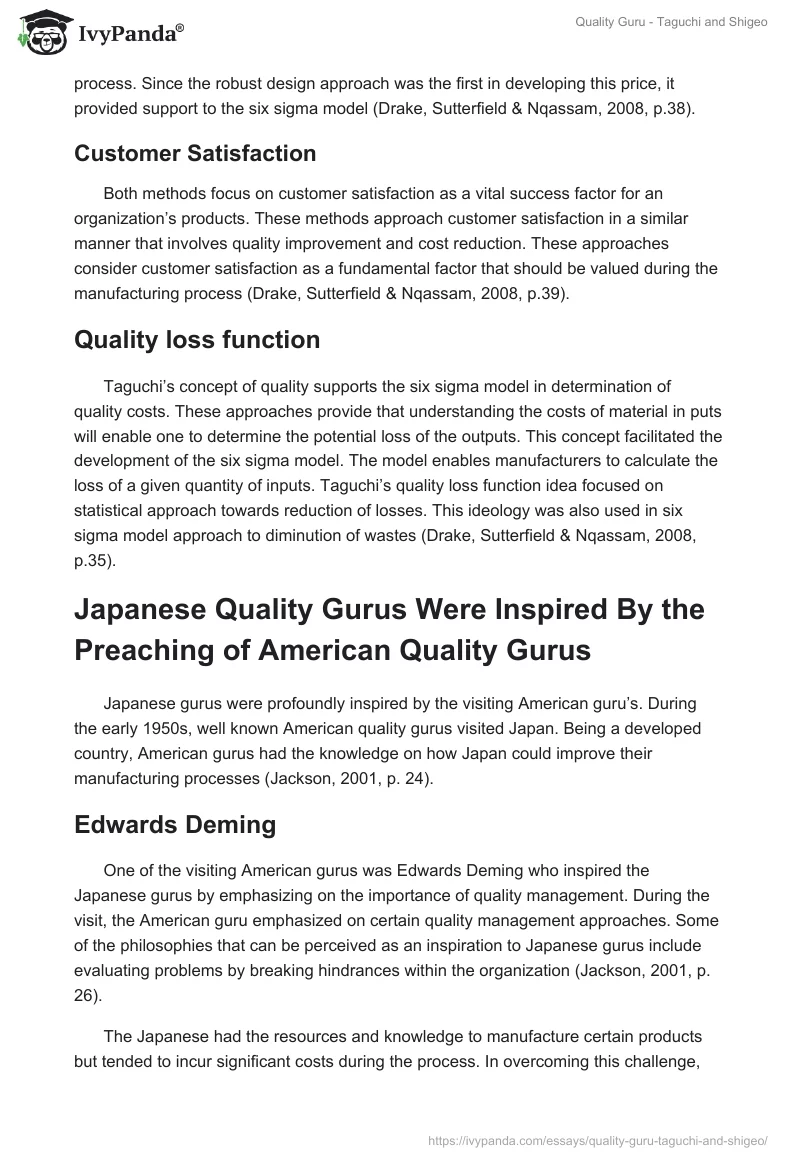Introduction
A quality guru can be described as an individual among all these. Quality gurus develop concepts and diverse approaches to quality within an organization that has a significant impact. Taguchi and Shigeo are the commonly known quality gurus. The success of the Japanese gurus can be attributed to the message that was delivered by American gurus back in 1950s. They developed quality management models in response to the American guru’s message (Jackson, 2001, p. 24).
Robust Design and quality loss function similarities to Six Sigma Concept
Robust design
Cost reduction
Dr. Genichi concept emphasized on the product design during the authentic manufacturing process. The idea of cost reduction during the manufacturing process was used in development of the six sigma model. Taghuchi provided the prerequisite idea on how to improve the quality of products as well as to reduce certain production costs. This provided a plat form for the development of the six sigma model that used the same approach on product development (Drake, Sutterfield & Nqassam, 2008, p.35).
Value improvement
Six sigma approach aims at managing the value of the final products. Robust design approach is similar to the six sigma model on the fact that both methods aim at reducing the time of production. The two methods emphasized on reduction of interval in production of products by considering the critical steps during the manufacturing process. Since the robust design approach was the first in developing this price, it provided support to the six sigma model (Drake, Sutterfield & Nqassam, 2008, p.38).
Customer Satisfaction
Both methods focus on customer satisfaction as a vital success factor for an organization’s products. These methods approach customer satisfaction in a similar manner that involves quality improvement and cost reduction. These approaches consider customer satisfaction as a fundamental factor that should be valued during the manufacturing process (Drake, Sutterfield & Nqassam, 2008, p.39).
Quality loss function
Taguchi’s concept of quality supports the six sigma model in determination of quality costs. These approaches provide that understanding the costs of material in puts will enable one to determine the potential loss of the outputs. This concept facilitated the development of the six sigma model. The model enables manufacturers to calculate the loss of a given quantity of inputs. Taguchi’s quality loss function idea focused on statistical approach towards reduction of losses. This ideology was also used in six sigma model approach to diminution of wastes (Drake, Sutterfield & Nqassam, 2008, p.35).
Japanese Quality Gurus Were Inspired By the Preaching of American Quality Gurus
Japanese gurus were profoundly inspired by the visiting American guru’s. During the early 1950s, well known American quality gurus visited Japan. Being a developed country, American gurus had the knowledge on how Japan could improve their manufacturing processes (Jackson, 2001, p. 24).
Edwards Deming
One of the visiting American gurus was Edwards Deming who inspired the Japanese gurus by emphasizing on the importance of quality management. During the visit, the American guru emphasized on certain quality management approaches. Some of the philosophies that can be perceived as an inspiration to Japanese gurus include evaluating problems by breaking hindrances within the organization (Jackson, 2001, p. 26).
The Japanese had the resources and knowledge to manufacture certain products but tended to incur significant costs during the process. In overcoming this challenge, the American guru insisted on development of statistical evidence after and prior to the manufacturing process. This principle enabled Japanese gurus to come up with statistical approaches in regard to improvement of quality of products in at low costs and less material wastage (Jackson, 2001, p. 26).
Joseph Muran
Dr. Muran was another American guru who visited Japan during the early 1950s. Muran developed a trilogy for quality improvement and the fundamental keys that can lead to the development. Muran emphasized on customer satisfaction through the use of certain techniques and approaches. These perceptions contributed to the creation of customer satisfaction awareness among the Japanese gurus. This knowledge enabled the Japanese gurus to consider customer satisfaction in development of their quality models (Jackson, 2001, p. 27).
Armand Feigenbaum
Armand was the original developer of total control of quality. Armand visited Japan in the early 1950’s and provided various steps that could be used to obtain and maintain product quality. Armand enabled Japanese gurus to incorporate leadership responsibility in their quality approaches and customer satisfaction. As a result, the Japanese gurus found the importance of developing their own approaches to quality improvement (Jackson, 2001, p. 28).
If there was a ‘Nobel Prize’ for Quality Management, Shigeo Shingo deserves it the Most
Shigeo’s contribution to quality improvement and management deserves an award. The concepts developed by this Japanese guru such as process and just in time approach have been globally been applied by a majority of Companies across the globe. Shigeo has used quality management methods that have produced satisfactory results. As a quality guru, Shingo has initiated a wide range of procedures and solutions to solve quality challenges among most multinational Companies (Fingleton, 2000, p. 47).
Shingo developed several systems that enabled organizations to distinguish between errors and defects. This was one of the major challenges that organizations were faced with in identifying ways to improve the quality. The contribution that Shingo has made in quality improvement has largely changed the quality of products. If there was a Nobel Prize for quality management, then with no doubt, Shingo deserved it Fingleton, 2000, p. 47).
Conclusion
Quality management is a decisive factor that should be considered during the manufacturing process. Robust design approach towards quality in the manufacturing process has various similarities with six sigma model. The similarities can be evaluated for the basic perspective of reduction of wastage, customer satisfaction and value increment. Quality improvement can be evaluated form the contribution made various quality gurus in Japan and America. After the visit, Japanese gurus began to develop approaches towards quality management in late 1950’s. Therefore, it can be assumed that American gurus inspired Japanese gurus.
References
Drake, D., Sutterfield, S. J. & Nqassam, C. (2008). “The Revolution of Six-sigma: an Analysis of Its Theory and Application”. Academy of Information and Management Sciences Journal, 11, pp. 35-45.
Fingleton, E. (2000). “The Forgotten Merits of Manufacturing”. Challenge Journal, 43, pp. 47-53.
Jackson, B. (2001). Management Gurus and Management Fashions: A Dramatistic Inquiry. New York, NY: Routledge.


